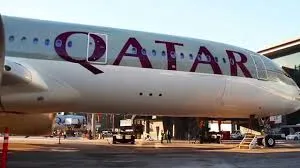
Qatar negotiating for airspace, report says.
Jun 19, 2017

Recent reports indicate that Qatar is engaged in negotiations to secure expanded access to airspace in the region. The discussions are aimed at enhancing its aviation capabilities and improving connectivity for both commercial and cargo flights. This move is seen as a strategic effort to strengthen Qatar’s position in the global aviation market, particularly in light of previous restrictions that limited its airspace access. The negotiations are expected to involve various stakeholders, including neighboring countries, as Qatar seeks to foster better diplomatic relations while boosting its economy through increased air traffic and tourism.
According to recent reports, Qatar is actively engaged in negotiations concerning its airspace, a critical aspect of its national and regional aviation strategy. This development is particularly significant in light of the geopolitical dynamics in the Gulf region, which have historically impacted air travel and airspace management. As Qatar seeks to enhance its aviation sector and foster better relations with neighboring countries, understanding the nuances of these negotiations becomes imperative.
The Importance of Airspace in Aviation
Airspace refers to the portion of the atmosphere controlled by a country. It is vital for safe and efficient air travel, impacting everything from flight routes to airport operations. For Qatar, a country that heavily relies on aviation for both tourism and commerce, efficient management of its airspace is essential. The ongoing negotiations may pave the way for improved "air traffic management" and more "direct flight routes", which can significantly reduce travel time and fuel costs.
Current Status of Negotiations
The latest reports indicate that Qatar is in discussions with several neighboring countries to establish agreements that would allow for more flexible use of its airspace. This could potentially lead to increased air traffic and enhanced operational efficiency for airlines operating in and out of the region. Key points of negotiation include:
| Negotiation Aspect | Description |
|---|---|
| Open Skies Agreements | Facilitating a more competitive environment for airlines. |
| Flight Path Adjustments | Implementing new routes to optimize air traffic. |
| Safety Protocols | Enhancing safety measures for all flights. |
| Environmental Concerns | Addressing pollution and noise concerns from increased air traffic. |
Impact on Regional Aviation
The potential outcomes of these negotiations could have significant ramifications for regional aviation. A more open airspace policy could lead to:
- Increased "tourism": Easier access to Qatar may boost its tourism sector, attracting more international visitors.
- Economic growth: The aviation sector contributes significantly to Qatar's GDP, and enhancing airspace usage could further stimulate economic activities.
- Stronger alliances: Improved relations with neighboring countries could foster better diplomatic ties and collaboration on various fronts.
Challenges in the Negotiation Process
While the potential benefits are promising, Qatar faces several challenges in its negotiations. These include:
- Geopolitical tensions: Ongoing disputes with some neighboring countries may complicate discussions and hinder progress.
- Regulatory hurdles: Each country has its own aviation regulations and standards, which may create barriers to reaching agreements.
- Safety concerns: Ensuring the safety of air travel in a more open airspace environment requires careful planning and coordination.
The Role of Technology in Airspace Management
As Qatar negotiates for more favorable airspace terms, the integration of advanced technology will be crucial. Innovations in "air traffic control" systems and real-time data sharing can significantly enhance the efficiency and safety of air travel. Technologies such as:
- Automated "air traffic management systems"
- Advanced "weather forecasting tools"
- Real-time flight tracking
These tools can help mitigate potential challenges and streamline operations, making the airspace more navigable for both commercial and private aircraft.
Future Prospects for Qatar's Aviation Sector
The outcome of Qatar's negotiations for airspace access could set a precedent for the future of its aviation industry. If successful, it may lead to:
- Expansion of "national airlines": Increased capacity for airlines to operate more flights and routes.
- Investment in infrastructure: Enhanced airport facilities and services to accommodate growing passenger numbers.
- Positioning as a regional hub: Strengthening Qatar's role as a key player in the global aviation market.
Conclusion
In summary, Qatar's negotiations for airspace access represent a pivotal moment for its aviation sector. The potential benefits of improved airspace management, stronger diplomatic ties, and economic growth are significant. However, challenges remain that must be navigated carefully. By leveraging technology and fostering cooperation with neighboring countries, Qatar can enhance its position in the aviation landscape while ensuring safety and efficiency for all stakeholders involved.
As these negotiations unfold, the world will be watching closely to see how they shape the future of air travel in the Gulf region and beyond.
Related Articles

Explore Thailand: The Best Islands to Visit for Paradise, Adventure, and Relaxation

The Ultimate Guide to the Best Islands in Thailand for Your Next Getaway

Do babies need passports? How to get a passport for a newborn

How to get a U.S. passport fast: here’s how to expedite the process

What is Mobile Passport Control: 5 reasons why you should use it

SENTRI vs. Global Entry: A detailed guide

Do you need a passport to go to the Bahamas? Let’s find out

Do you need a passport to go to Mexico? A detailed guide

Do you need a passport to go to Canada? We got the answer

Do You Need a Passport for a Cruise: An Essential Travel Guide

Booster Seat Requirements: All the Rules to Follow in Your Rental Car

What Are the World’s Most Powerful Passports, and How Does Yours Rank?

How to Take a Passport Photo at Home: A Helpful Guide

You've got to have heart! Southwest's new livery

Your opinion: Should water be free on low cost carriers?

Young women bolder than guys as solo travellers
